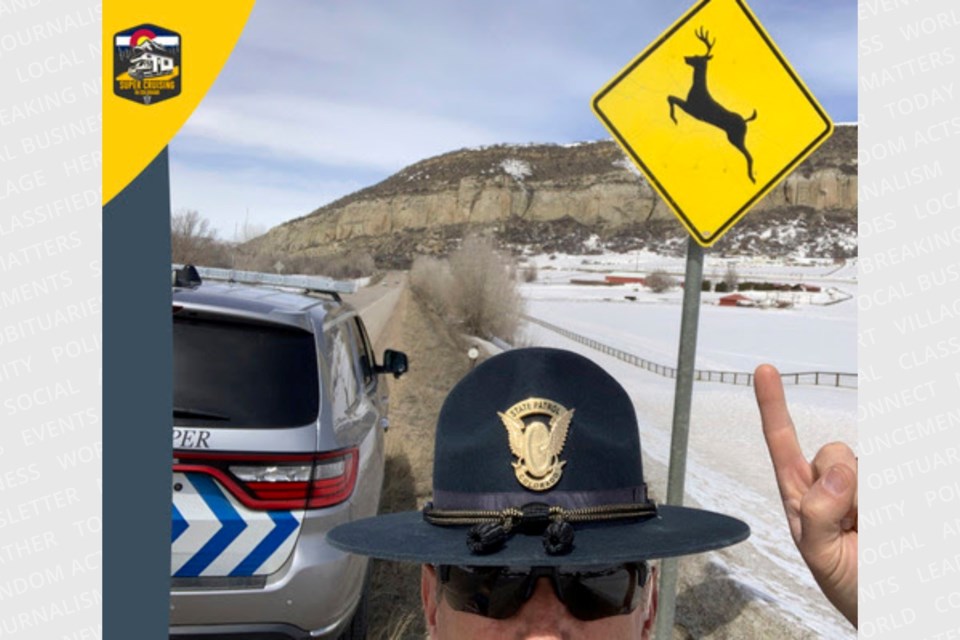NEWS RELEASE
COLORADO STATE PATROL
*********************
It’s that time of year for pumpkin patches and a drive through the Colorado Rockies to check out the changing of the season; oh, it is also rutting (aka mating) season for elk. The western slope of Colorado regularly sees a steady volume of in-state and out-of-state visitors throughout the autumn ‘shoulder season.’ Recreationists may not always be familiar with the region’s roadways, towing in mountain conditions, or wildlife.
Seeing the reflection of two eyes from an animal on the road in front of you can send a wave of adrenaline and fear through even the most experienced drivers, so the Colorado State Patrol would like to assist by providing some general recommendations to lower the chance of a critter collision.
Two of the most important things a motorist can do is to drive the speed limit and use your high beams when not around other motorists in rural areas or neighborhoods adjacent to open space areas. Increase your chances of seeing wildlife crossing up ahead or on the side of the road by staying alert. You can give yourself the time to adjust your speed or stop if no one is behind you.
“The worst choice you can make is to swerve outside your lane or slam on your brakes with vehicles behind you,” explained Major David Rollins, District 4 Commander for the Colorado State Patrol. “People can end up in serious crashes when they let their emotions take over to save Bambi or his friends.”
Be prepared to make a tough decision when encountering animals. If you have time and space, you can sound your horn and slow down in a straight line, coming to a stop. You can brake hard in a straight line if you have very little time and distance and no one is behind you. However, if there is little time and traffic behind you, the right choice is to drive through, keeping in the lane, but with a slight angle towards the butt of the animal ONLY if by the white side lane line. Never swerve or jerk the wheel.
As a resource to visitors in the area, the Colorado State Patrol has updated its Super Cruising in Colorado web resource to help prepare visitors for the scenic byways and mountain roadways throughout the area.
In addition to videos of some popular leaf-peeping routes, visitors to the website can also find information on how to navigate various mountain conditions like steep turns and blind corners while also being linked to local weather information and how to load a trailer to avoid swaying properly.
Fall driving tips:
- Beware of quickly changing temperatures. Temperatures change with altitude. Some mountain passes can bring you up and down thousands of feet within a short distance. When you start climbing a mountain, it can be sunny, clear blue skies, and by the time you reach the top of the pass, it can be blizzard conditions.
- Fog can be a huge issue, especially in the valleys. Visibility can go from being clear to being extremely limited literally in seconds.
- The colorful leaves may be pretty, but leaves on the road can be dangerous when wet. Driving on slippery leaves can be similar to driving on ice! Leaves can also obstruct traffic lines, potholes, or pavement markings.
- The days are becoming shorter which means visibility is reduced. Turn on your headlights and watch for pedestrians walking or biking on the roadway at dawn, dusk, or night.
- With the time change, the sun rises and sets at different times causing dangerous sun glare. Keep a pair of sunglasses in your car that you can wear to reduce sun glare.
- The cool overnight temperatures bring morning frost. Keep a snow broom/ice remover in your car and give yourself extra time to clear your windows of frost before you start driving. Make sure your wipers and defrosters are working as they should.
- Watch for deer and elk! Deer and elk accidents are common in the Fall because it’s mating season. If you see a deer or elk, proceed cautiously and slow down as they often travel in groups. Remember that deer are most active at dawn and dusk.
- Check your tire pressure. Temperatures fluctuate a lot in the autumn. This will cause your tires to expand and contract, ultimately leading to a loss of pressure, something you don’t want to worry about when on the road. Monitor your tire pressure regularly.
- Don’t Park where it says no parking. It is no parking for a reason and that is probably for safety or to protect the environment right there.
*********************



